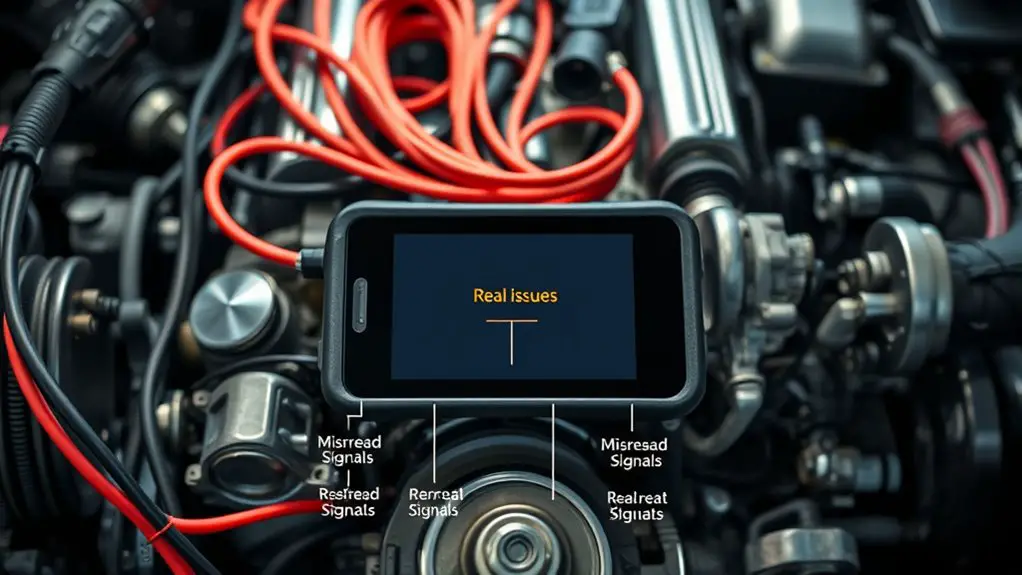How to Build a Troubleshooting Flow for False Error Codes
To build a robust troubleshooting flow, start by separating true faults from false error codes using disciplined data collection and cross-checks across multiple sensors. Map real versus misread signals, isolate inputs, and reproduce results to confirm causality. design a repeatable flow: define precise symptoms, run short, noninvasive tests, and log outcomes. Use decision trees aligned with workflows, tag owners, and document verification steps. Implement quick wins, then iterate to prevent recurrence—you’ll uncover deeper techniques as you continue.
Understanding False Error Codes: Why They Happen

False error codes aren’t random flukes; they usually point to a mismatch between what the system is reporting and what’s actually happening. You’re not chasing ghosts; you’re tracing signals to their real source. Understanding why error codes appear requires you to examine two ideas: error code origins and system miscommunication. First, determine where the signal starts—sensor, logic, or interface—and map how it travels to the display. If the message is inconsistent with observed behavior, blame miscommunication between subsystems, not incompetence. Second, verify timing and state changes; a delayed or stale reading can generate misleading codes. Third, check thresholds, calibration, and data formats; mismatches there produce premature or phantom errors. Finally, isolate components to see whether the code persists when variables shift. By focusing on origins and communication pathways, you gain clarity, reduce noise, and empower decisive action without unnecessary alarm.
Mapping Real vs. Misread Signals

To map real versus misread signals, you’ll compare what you expect to see with what the system actually reports. Start by distinguishing true errors from user or sensor misreads, and note how perception can skew the data. This sets the stage for precise verification steps and reduces false alarms.
Real vs. Perceived Signals
In real-versus-perceived signals, you’ll learn to distinguish what’s actually occurring from what your sensors or instincts suggest. You approach data with a disciplined mindset: verify, not assume, and separate noise from signal. Real signals reflect measurable conditions you can reproduce or observe under controlled tests. Perceived signals arise from expectations, prior experience, or environmental cues that bias interpretation. Your method: isolate inputs, document context, and reproduce results to confirm causality. When a fault appears, compare readings across multiple instruments and time scales to confirm consistency. Question anomalies: could interference, timing, or calibration skew results? Keep a log for each observation, noting confidence levels. By aligning perception with verifiable data, you maintain clarity, autonomy, and freedom in troubleshooting. real signals, perceived signals.
Distinguishing True Errors
From real signals established in the prior section, you’ll map which readings truly indicate a fault and which are misreads. You’ll use error identification techniques to separate signals with fault potential from noise, then apply signal differentiation methods to confirm validity. This phase assigns truth values to each alert, enabling targeted interventions rather than overreaction.
| Step | Action | Outcome |
|---|---|---|
| 1 | Gather readings | Baseline of normal vs. anomaly |
| 2 | Cross-check sources | Consistency across sensors |
| 3 | Apply criteria | True fault vs. nuisance |
| 4 | Decide response | Minimal disruption, rapid fix |
Adopt a calm, deliberate cadence, favoring measurable criteria over guesses. You’ll gain confidence when you can repeat results, and freedom grows from dependable systems, not alarms.
Gathering Data That Drills Down to the Root Cause

You start by selecting the right data points to test your hypothesis and map how each one could signal the root cause. Next, you follow a structured hypothesis testing steps, ruling in or out possibilities with focused checks. Finally, you translate findings into a root cause map that guides targeted fixes and verification.
Data Point Selection
Data point selection is about quickly pinpointing what to measure so you can trace a fault to its root cause. You’ll choose indicators that reflect system state, input conditions, and timing, not guesswork. Focus on data relevance: prioritize measurements that directly impact the error code’s meaning and the observed behavior. Prioritize stable, representative signals over noisy outliers, and map each point to a hypothesis you’re testing. Guarantee data integrity by validating sources, timestamps, and units before capture. Document each chosen point’s purpose and acceptance criteria so the flow remains transparent and repeatable. Keep the set lean: remove redundant measurements and avoid overfitting to a single incident. With disciplined selection, you’ll expose causal threads without drowning in data.
Hypothesis Testing Steps
Once you’ve identified relevant data points, you’ll test hypotheses by formulating clear, falsifiable statements about how each measure relates to the fault. Now you translate data into direction: hypothesis formulation guides every step, and experimental design tests those claims with discipline.
1) Define measurable expectations that distinguish true from false signals.
2) Prioritize controls, variables, and replication to reveal consistent patterns.
3) Schedule rapid, repeatable tests to build evidence efficiently.
4) Document outcomes succinctly, updating hypotheses as results arrive.
This approach keeps you objective, minimizes bias, and preserves freedom to iterate. You’ll move from conjecture to confirmation with precision, ensuring each test narrows the gap toward the root cause without overreaching.
Root Cause Mapping
Root Cause Mapping begins with gathering targeted data that drills down to the fault’s origin. You map symptoms to causes using root cause analysis, anchoring decisions in observable facts rather than assumptions. Start with an impact assessment to prioritize issues by effect, then pursue error categorization to group similar signals. Differentiate signals through clear signal differentiation, isolating true faults from noise. Seek robust system feedback to confirm findings and refine hypotheses in real time. Employ a disciplined process evaluation to reveal gaps, bottlenecks, or latent flaws. Tie findings to corrective measures that address root causes, not just symptoms. Maintain data integrity across sources and document using consistent analysis frameworks. This approach supports efficiency optimization while guiding your team toward precise, actionable conclusions.
Designing a Repeatable Diagnostic Flow
Designing a repeatable diagnostic flow starts with a clear, repeatable sequence: identify the symptom, gather known variables, and apply a disciplined set of checks that isolate the fault without bias. You’ll structure the flow around objective criteria, minimize assumptions, and document each step for repeatability. This is the essence of diagnostic methodology and error analysis in practice.
Design a repeatable diagnostic flow: define symptoms, gather relevant data, and test objectively without bias.
1)Define the symptom precisely, noting boundaries, timestamps, and observed effects.
2)Collect relevant variables, including prior results, environment, and recent changes.
3)Apply a logical, bias-free test plan that progresses from noninvasive to invasive as needed.
4)Capture outcomes and update the hypothesis, switching gears only when evidence demands it.
The goal is clarity over cleverness, speed over guesswork, and accountability over vagueness. You’ll maintain consistency across trials, enabling parallel teams to reproduce results and learn. Freedom comes from reliable process, not flaky intuition.
Lightweight Validation Techniques for Quick Wins
Lightweight validation techniques focus on rapid, low-cost checks that confirm whether a suspected fault is plausible before deeperinvestigation. You’ll implement quick assessments that don’t disrupt flow but still surface obvious disparities. Use lightweight tools to confirm a baseline, then sanity-check inputs, timing, and basic state. Validation methods should be repeatable and fast, delivering rapid feedback so you can pivot without buried ambiguity. Prioritize signal clarity: separate noise from meaningful spikes, and mark anomalies with simple, reproducible criteria. Error reduction happens when you strip complexity to core evidence—whether a sensor is in-range, a flag is set, or a log entry aligns with expectations. Efficient testing means short cycles, automated light-touch checks, and clear pass/fail signals. You’ll document results succinctly, so decisions aren’t stalled by interpretive doubt. The goal is confident triage that accelerates truth, not overwhelm with irrelevant data.
Implementing Decision Trees Aligned With Workflows
When you implement decision trees that align with your workflows, you map each branch to a concrete step, outcome, or decision point already defined in the process. This alignment clarifies roles, reduces ambiguity, and speeds diagnosis. By tying decision points to workflow icons, you create visual semantics that teams can follow without hesitation. Focus on decision tree design that mirrors real-world actions, not idealized steps. Ascertain each branch leads to measurable next actions and owners, so feedback loops stay tight and observable. This workflow integration enables consistent troubleshooting across teams and tools, making false codes easier to isolate and reject.
Align decision trees with real workflows, mapping branches to concrete steps, owners, and SLAs for fast, measurable troubleshooting.
- Define entry and exit criteria for every decision node.
- Tag branches with owners and service levels.
- Validate branches against actual incident data.
- Refine iteratively to prevent drift and maintain clarity.
Communicating Findings and Preventing Recurrence
Communicating findings clearly is essential to prevent recurrence: summarize what failed, why it happened, and how it was verified, using plain language and concrete examples. You start by stating the root cause in one sentence, then connect it to the observable failure. For instance, “the sensor drifted by 2%, causing a false code during startup.” Next, outline verification steps you used, such as logs, tests, and reproducibility checks, so teammates can confirm the result without guesswork. Use concise, actionable recommendations: implement a threshold adjustment, add a timeout, and monitor the relevant metric in real time. Document who reviewed the results and when decisions were made. Emphasize communication strategies that keep stakeholders aligned—short summaries, updated runbooks, and clear ownership. Maintain thorough error documentation to prevent ambiguity later. Finally, schedule follow-ups to validate that the preventive actions worked, and store lessons learned for future incidents.
Frequently Asked Questions
How to Prioritize False Error Codes by Impact?
Impact-based prioritization hinges on impact assessment and error frequency. You’ll rank false error codes by how severely they disrupt users and operations, then weigh how often they appear. Start with high-impact, high-frequency codes, triage promptly, and log patterns. For lower-impact items, monitor trends before action. You’ll allocate resources to worst offenders first, refine thresholds, and update your flow. This method keeps you precise, purposeful, and free to focus on what truly matters.
When to Stop Chasing a Misread Signal?
You stop chasing a misread signal when you hit clear troubleshooting thresholds: confirmed false positives, reproducibility gaps, and diminishing returns. You’re free to move on once data trends stabilize, tests converge, and false error codes stop surfacing. Document the decision, review root causes, and set guardrails to prevent drift. You measure progress by throughput, not delay. Trust your metrics, not rumor, and exit with confidence when signals no longer justify pursuit.
Which Metrics Indicate Diagnostic Flow Effectiveness?
You’ll know a diagnostic flow is effective when metric analysis shows steady high diagnostic accuracy and balanced false positive/false negative rates. Track cycle time, hit rate, and escalation frequency to guarantee prompt yet thorough conclusions. Compare prior vs. current results to confirm improvement. In practice, you measure consistency across teams, document edge cases, and adjust thresholds as needed. You’ll gain clarity, confidence, and freedom as accuracy improves without overburdening decision makers.
How to Handle Conflicting Data Sources During Triage?
When you encounter conflicting data during triage, you prioritize data integration and source validation first. You’ll align sources, note discrepancies, and flag trust levels before acting. You compare timestamps, guarantee consistent units, and document the rationale for choosing one data point over another. You test a reconciled set against known baselines, then proceed with caution. You stay agile, verify changes, and keep the process transparent so you can adjust quickly if new evidence emerges.
What Roles Are Essential in a Troubleshooting Team?
Did you know 30% of outages stem from unclear ownership? In a troubleshooting team, essential roles include a team lead, data collector, subject-matter expert, and communicator. You’ll rely on clear team roles and robust communication strategies to align actions, share findings, and avoid duplication. You, as a practitioner, must own updates, document decisions, and iterate quickly. Stay concise, precise, and methodical, yet preserve room for initiative and autonomy within the team.





